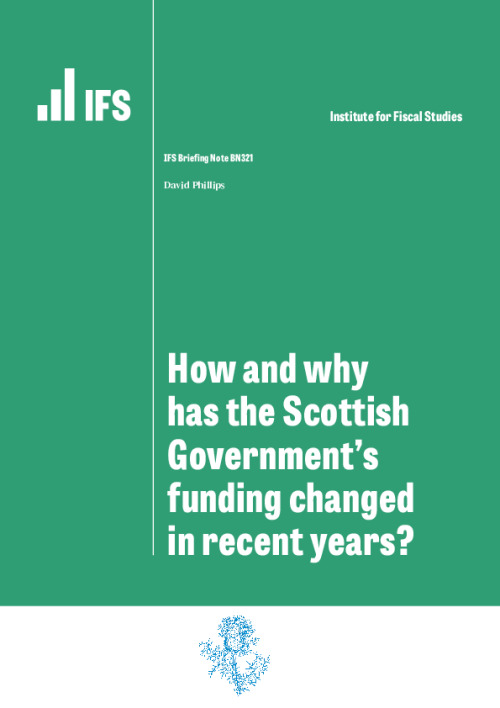The last ten or so years have seen big changes to the level and composition of the Scottish Government’s budget. Broadly speaking, the period between 2010–11 and 2017–18 was one of austerity, with real-terms funding for day-to-day (or resource) spending falling by 6% over the seven years. Since then though, funding has been increasing. It had almost returned to 2010–11 levels by 2019–20 and, excluding the additional temporary funding being provided by the UK government to address the COVID-19 pandemic, plans suggest ‘core’ funding will be around 3% higher in 2021–22. However, after accounting for population growth, it will still be around 2% lower per person. These trends largely reflect changes in funding from the UK government, although the use of devolved tax, borrowing and reserve powers has also had a growing impact on the Scottish Government’s overall funding.
Key findings
- Although fiscal devolution has seen the Scottish Government set and keep more of its own taxes, block grant funding from the UK government is still set to contribute two-thirds of its resource (i.e. non-investment) budget in the year just ending, 2020–21. Scottish income tax will contribute 27% of its funding and other Scottish taxes 5.5%, with borrowing contributing the remaining 0.5%.
- The Scottish Government’s resource funding fell by 6% between 2010–11 and 2017–18, driven by cuts to block grant funding from the UK government. Funding has since increased, largely driven by increases in the block grant, with ‘core’ resource funding set to be 3% higher in the coming financial year, 2021–22, than in 2010–11. However, this still represents a reduction of 2% per person over this 11-year period.
- The Scottish Government has received around £9.5 billion in additional COVID-19 related funding from the UK government in 2020–21. This is equivalent to £1,370 per person in Scotland. It has been allowed to carry forward £874 million of this on top of its usual powers to hold and use reserves, which is a greater degree of flexibility than provided to UK government departments serving England. When combined with a special ‘funding guarantee’, this means that the Scottish Government will almost certainly receive more funding per person to address COVID-19 over these two years than is spent in England.
- After accounting for these financial flexibilities, funding to address the COVID-19 pandemic in Scotland will be £8.6 billion in 2020–21 (£9.5 billion minus £874 million) and £4.2 billion in 2021–22 (£3.3 billion of block grant funding plus £874 million). It is worth noting that not all of the extra funding in 2021–22 will be used to address the direct effects of the COVID-19 pandemic – some is being used to extend free school meals and free bus travel, for example. Paying for such policies may be more difficult in 2022–23 and beyond, when this temporary funding is currently planned to cease, and the money must be found from within core budgets.
- That core funding is likely to be tight. In particular, the overall spending envelope pencilled in by the UK government in its March Budget imply spending £14 billion less on unprotected budgets in 2022-23 than was planned before the COVID-19 crisis. Fairly hefty increases in NHS and schools spending in England mean that the Barnett formula should still deliver a small increase in core funding in 2022-23 for the Scottish Government. But if the Scottish Government channels this money to the NHS and schools too, without additional funding from the UK government in its upcoming Spending Review or increases in Scottish taxes, spending on some services will likely need to be reduced in real-terms.
- Scottish Government tax revenues have had a modest, but growing impact on its resource budget over time. For example, Scotland’s more progressive and more complicated five-band income tax system and lower threshold for higher (41%) rate income tax are estimated to raise around £456 million more in 2020–21 than if policy had remained the same as in the rest of the UK. However, forecasts suggest the Scottish Government will ultimately receive only £117 million more in funding as a result of devolved income tax powers. This is because weaker underlying growth in the income tax base – mostly due to slower earnings growth in the late 2010s – offsets most of the extra revenues from its income tax policy reforms.
- The majority of funding for Scottish Government capital investment spending comes from the UK government. This block grant funding was reduced by 22% between 2010–11 and 2015–16 as investment spending in England was cut, but has been increasing since, and is set to be at least 7% above 2010–11 levels in the current financial year. The Scottish Government is also able to borrow up to £450 million a year and smooth spending by using reserves, and in recent years, net borrowing has averaged almost 10% of block grant funding for capital investment. Accounting for net borrowing, overall investment spending this year is set to be at least 16% higher than in 2010–11.
- Total ‘core’ Scottish Government funding (resource plus capital) per person in 2020–21 is approximately 131% of what is being provided to UK government departments for spending in England. Higher funding levels are driven almost entirely by higher block grant funding from the UK government. In turn, this reflects two factors. First, that the Barnett formula used to allocate funding to the Scottish Government does not account for Scotland’s lower population growth. Second, that the formula had a flaw up until 2015–16 that meant Scotland was insulated from the cuts it would have faced as a result of cuts to local government funding in England under a corrected formula.










